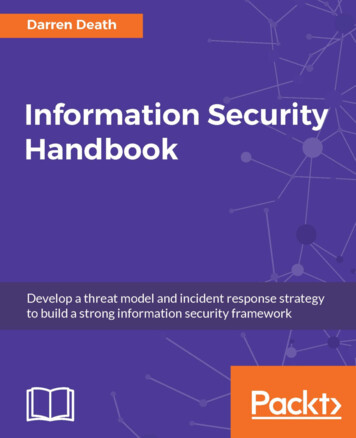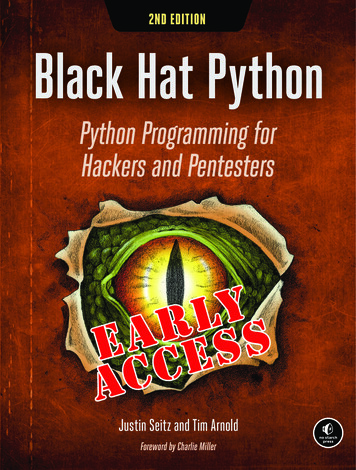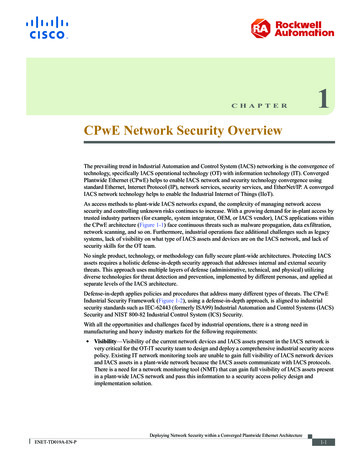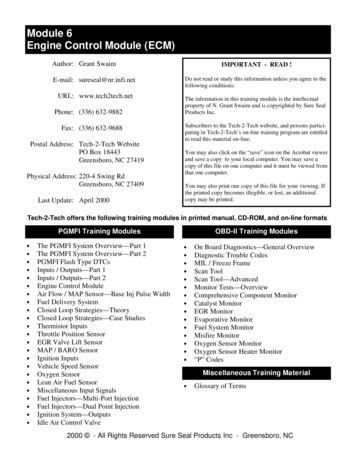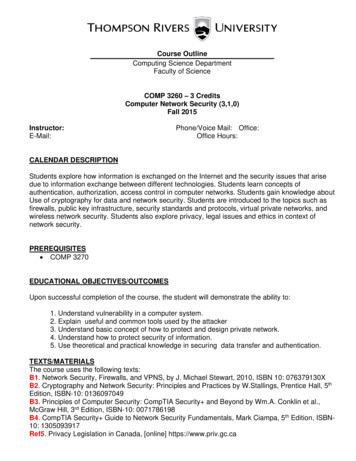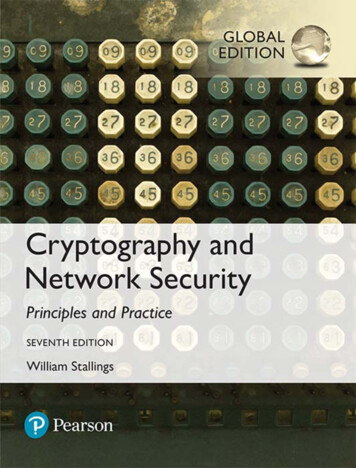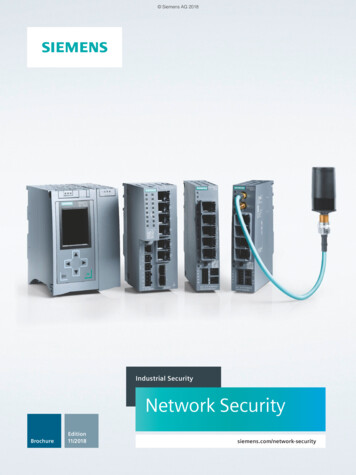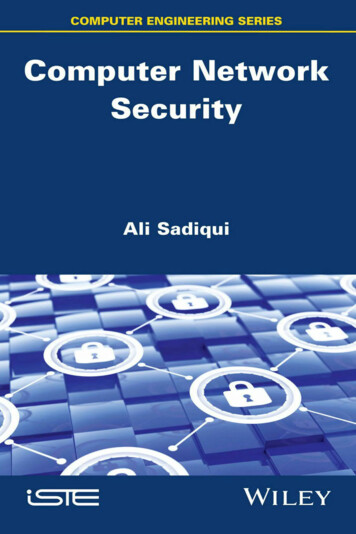
Transcription
Computer Network Security
Series EditorJean-Charles PomerolComputer Network SecurityAli Sadiqui
First published 2020 in Great Britain and the United States by ISTE Ltd and John Wiley & Sons, Inc.Apart from any fair dealing for the purposes of research or private study, or criticism or review, aspermitted under the Copyright, Designs and Patents Act 1988, this publication may only be reproduced,stored or transmitted, in any form or by any means, with the prior permission in writing of the publishers,or in the case of reprographic reproduction in accordance with the terms and licenses issued by theCLA. Enquiries concerning reproduction outside these terms should be sent to the publishers at theundermentioned address:ISTE Ltd27-37 St George’s RoadLondon SW19 4EUUKJohn Wiley & Sons, Inc.111 River StreetHoboken, NJ 07030USAwww.iste.co.ukwww.wiley.com ISTE Ltd 2020The rights of Ali Sadiqui to be identified as the author of this work have been asserted by him inaccordance with the Copyright, Designs and Patents Act 1988.Library of Congress Control Number: 2019952965British Library Cataloguing-in-Publication DataA CIP record for this book is available from the British LibraryISBN 978-1-78630-527-5
ContentsPreface . . . . . . . . . . . . . . . . . . . . . . . . . . . . . . . . . . . . . . . . . .xiIntroduction . . . . . . . . . . . . . . . . . . . . . . . . . . . . . . . . . . . . . . .xiiiChapter 1. Fundamentals of Network Security . . . . . . . . . . . . . . .11.1. Introduction . . . . . . . . . . . . . . . . . . . . . . . . . . . . . .1.1.1. The main objectives of securing a network . . . . . . . . .1.1.2. Information security terminology . . . . . . . . . . . . . .1.2. Types of network security . . . . . . . . . . . . . . . . . . . . .1.2.1. Physical security . . . . . . . . . . . . . . . . . . . . . . . .1.2.2. Logical security . . . . . . . . . . . . . . . . . . . . . . . . .1.2.3. Administrative security . . . . . . . . . . . . . . . . . . . .1.3. The main risks related to the logical security of the network .1.3.1. Different kinds of network attacks . . . . . . . . . . . . . .1.3.2. Network security measures . . . . . . . . . . . . . . . . . .1.3.3. Vulnerability audit measures . . . . . . . . . . . . . . . . .1.4. Exercises to test learning . . . . . . . . . . . . . . . . . . . . . .122444555788Chapter 2. Securing Network Devices . . . . . . . . . . . . . . . . . . . . .152.1. Types of network traffic . . . . . . . . . . . . . . . . . . . . . .2.2. Securing the management plan . . . . . . . . . . . . . . . . . .2.3. Securing passwords . . . . . . . . . . . . . . . . . . . . . . . . .2.4. Implementing connection restrictions . . . . . . . . . . . . . .2.4.1. Configuring a login banner . . . . . . . . . . . . . . . . . .2.4.2. Configuring connection parameters . . . . . . . . . . . . .2.5. Securing access through console lines, VTY and auxiliaries .2.5.1. Securing access through the console lineand deactivating the auxiliary line . . . . . . . . . . . . . . . . . .2.5.2. Securing VTY access with ssh . . . . . . . . . . . . . . . .15161617171718. . . . . . . . . . .1818
viComputer Network Security2.6. Allocation of administrative roles. . . . . . . . . . . .2.6.1. Privilege levels of the IOS system . . . . . . . . .2.6.2. Configuring a privilege level . . . . . . . . . . . .2.6.3. Setting a privilege level per user . . . . . . . . . .2.6.4. Setting a privilege level for console,VTY, and auxiliary line access . . . . . . . . . . . . . . .2.6.5. Securing access with the managementof “views” and “super-views” . . . . . . . . . . . . . . .2.6.6. Securing configuration files and the IOS system2.6.7. Using automated security features . . . . . . . . .2.7. Securing the control plane . . . . . . . . . . . . . . . .2.7.1. Introduction . . . . . . . . . . . . . . . . . . . . . .2.7.2. MD5 authentication . . . . . . . . . . . . . . . . .2.7.3. Configuring OSPF protocol authentication . . . .2.7.4. Configuring EIGRP protocol authentication . . .2.7.5. Configuring RIP authentication . . . . . . . . . .2.8. Exercises for application . . . . . . . . . . . . . . . . .19191920. . . . . . . . . . .20.21222324242424252626Chapter 3. Supervising a Computer Network . . . . . . . . . . . . . . . .413.1. Introduction . . . . . . . . . . . . . . . . . . . . . . . . . . . . . . . . . .3.2. Implementing an NTP server . . . . . . . . . . . . . . . . . . . . . . .3.2.1. Introduction to the NTP . . . . . . . . . . . . . . . . . . . . . . . .3.2.2. How the NTP works . . . . . . . . . . . . . . . . . . . . . . . . . .3.2.3. NTP configuration . . . . . . . . . . . . . . . . . . . . . . . . . . .3.3. Implementing a Syslog server . . . . . . . . . . . . . . . . . . . . . . .3.3.1. Introduction to the Syslog . . . . . . . . . . . . . . . . . . . . . . .3.3.2. How Syslog works . . . . . . . . . . . . . . . . . . . . . . . . . . .3.3.3. Configuring a Syslog client . . . . . . . . . . . . . . . . . . . . . .3.4. Implementing the Simple Network Management Protocol (SNMP)3.4.1. Introducing the SNMP . . . . . . . . . . . . . . . . . . . . . . . . .3.4.2. How SNMP works . . . . . . . . . . . . . . . . . . . . . . . . . . .3.4.3. SNMP configuration . . . . . . . . . . . . . . . . . . . . . . . . . .3.5. Exercises for application . . . . . . . . . . . . . . . . . . . . . . . . . .4142424243444445464646474950Chapter 4. Securing Access Using AAA . . . . . . . . . . . . . . . . . . .674.1. Introduction . . . . . . . . . . . . . . . . . . .4.2. AAA authentication . . . . . . . . . . . . . .4.2.1. Local AAA authentication . . . . . . .4.2.2. AAA authentication based on a server4.3. AAA authorizations . . . . . . . . . . . . . .4.4. AAA traceability . . . . . . . . . . . . . . . .4.5. Exercises for application . . . . . . . . . . .67686869717172
ContentsChapter 5. Using Firewalls . . . . . . . . . . . . . . . . . . . . . . . . . . . . .5.1. Introducing firewalls . . . . . . . . . . . . . . . . . .5.2. Types of firewalls . . . . . . . . . . . . . . . . . . . .5.3. Setting up a firewall . . . . . . . . . . . . . . . . . . .5.4. Different firewall strategies . . . . . . . . . . . . . .5.5. ACL-based firewalls . . . . . . . . . . . . . . . . . .5.5.1. Introduction . . . . . . . . . . . . . . . . . . . . .5.5.2. The location of ACLs . . . . . . . . . . . . . . .5.5.3. IPv4 ACLs . . . . . . . . . . . . . . . . . . . . . .5.5.4. IPv6 ACLs . . . . . . . . . . . . . . . . . . . . . .5.5.5. ACL recommendation . . . . . . . . . . . . . . .5.6. Zone-based firewalls . . . . . . . . . . . . . . . . . .5.6.1. Introduction . . . . . . . . . . . . . . . . . . . . .5.6.2. Types of security zones in a network . . . . . .5.6.3. Rules applied to interzone traffic . . . . . . . . .5.6.4. Terminology . . . . . . . . . . . . . . . . . . . . .5.6.5. Configuring a ZFW . . . . . . . . . . . . . . . . .5.7. Creating zones . . . . . . . . . . . . . . . . . . . . . .5.8. Creating Class-Maps . . . . . . . . . . . . . . . . . .5.9. Creating the Policy-Map to apply the Class-Maps .5.10. Defining the zone pairs . . . . . . . . . . . . . . . .5.11. Applying the policy maps to the zone pairs . . . .5.12. Assigning interfaces to zones . . . . . . . . . . . .5.13. Exercises for application . . . . . . . . . . . . . . pter 6. Putting in Place an Intrusion Prevention System (IPS) .101.79.6.1. Introduction to a detector . . . . . . . . . . . . . .6.2. The differences between an IDS and an IPS . .6.3. Types of IPS . . . . . . . . . . . . . . . . . . . . .6.4. Cisco IP solutions . . . . . . . . . . . . . . . . . .6.5. Modes of deploying IPS . . . . . . . . . . . . . .6.6. Types of alarms . . . . . . . . . . . . . . . . . . .6.7. Detecting malicious traffic . . . . . . . . . . . . .6.7.1. Modes of detection . . . . . . . . . . . . . . .6.7.2. Signature-based detection . . . . . . . . . . .6.7.3. Other modes of detecting malicious traffic .6.8. Signature micro-engines . . . . . . . . . . . . . .6.9. Severity levels of the signatures . . . . . . . . . .6.10. Monitoring and managing alarms and alerts . .6.11. List of actions to be taken during an attack . .6.12. Configuration of an IOS IPS . . . . . . . . . . .6.13. Recommended practices . . . . . . . . . . . . .6.14. Exercises for application . . . . . . . . . . . . 111112
viiiComputer Network SecurityChapter 7. Securing a Local Network . . . . . . . . . . . . . . . . . . . . .7.1. Introduction . . . . . . . . . . . . . . . . . . . . . . .7.2. Types of attacks on Layer 2 . . . . . . . . . . . . .7.2.1. MAC address flooding attacks . . . . . . . . .7.2.2. MAC spoofing attack . . . . . . . . . . . . . .7.2.3. The DHCP starvation attack . . . . . . . . . .7.2.4. VLAN hopping attacks. . . . . . . . . . . . . .7.2.5. STP-based attacks . . . . . . . . . . . . . . . .7.3. The best security practices for protecting Layer 27.4. Exercises for application . . . . . . . . . . . . . . .125126126127127128130131132Chapter 8. Cryptography . . . . . . . . . . . . . . . . . . . . . . . . . . . . . .1438.1. Basic concepts in cryptography . . . . . . . .8.1.1. Definition . . . . . . . . . . . . . . . . . .8.1.2. Terminology . . . . . . . . . . . . . . . . .8.2. The different classifications of cryptology .8.2.1. Traditional cryptography . . . . . . . . .8.2.2. Modern cryptography . . . . . . . . . . .8.2.3. Symmetric and asymmetric encryption .8.3. Key management . . . . . . . . . . . . . . . .8.3.1. Introduction . . . . . . . . . . . . . . . . .8.3.2. Diffie-Hellman key exchange. . . . . . .8.4. Hash functions . . . . . . . . . . . . . . . . . .8.5. HMAC codes . . . . . . . . . . . . . . . . . . .8.6. Asymmetric cryptography . . . . . . . . . . .8.6.1. Introduction . . . . . . . . . . . . . . . . .8.6.2. How it works . . . . . . . . . . . . . . . .8.6.3. Digital signatures . . . . . . . . . . . . . .8.6.4. Public key infrastructure . . . . . . . . . .8.7. Exercises for application . . . . . . . . . . . .173.Chapter 9. IPsec VPNs . . . . . . . . . . . . . . . . . . . . . . . . . . . . . . . 55159.9.1. The IPsec protocol . . . . . . . . . .9.1.1. Objectives of IPsec . . . . . . .9.1.2. Basic IPsec protocols. . . . . .9.1.3. The IPsec framework. . . . . .9.1.4. The IPsec security association9.1.5. IPsec modes . . . . . . . . . . .9.2. IKE protocol . . . . . . . . . . . . .9.2.1. Introduction . . . . . . . . . . .9.2.2. Components of IKE . . . . . .9.2.3. IKE phases . . . . . . . . . . . .125.173173174174175175176176176176
Contents9.3. The site-to-site VPN configuration .9.3.1. Introduction . . . . . . . . . . . .9.3.2. Configuration of IPsec VPN . .9.4. Exercises for application . . . . . . .178178179181Chapter 10. Studying Advanced Firewalls . . . . . . . . . . . . . . . . . .18910.1. Cisco ASA firewalls . . . . . . . . . . . . . . . . . .10.1.1. Introduction . . . . . . . . . . . . . . . . . . . .10.1.2. ASA models . . . . . . . . . . . . . . . . . . . .10.1.3. Modes for using ASA devices. . . . . . . . . .10.1.4. An overview of ASA 5505 . . . . . . . . . . .10.1.5. ASA levels of security . . . . . . . . . . . . . .10.1.6. Configuring an ASA with CLI . . . . . . . . .10.2. Exercises for application . . . . . . . . . . . . . . .10.3. Configuring Cisco elements with graphical tools .10.3.1. An overview of the CCP . . . . . . . . . . . . .10.3.2. An overview of the ASDM . . . . . . . . . . .10.3.3. Using CCP and ASDM . . . . . . . . . . . . . .10.4. The TMG 2010 firewall . . . . . . . . . . . . . . . .10.4.1. Introduction . . . . . . . . . . . . . . . . . . . .10.4.2. Installation and configuration . . . . . . . . . eferences . . . . . . . . . . . . . . . . . . . . . . . . . . . . . . . . . . . . . . . .243Index . . . . . . . . . . . . . . . . . . . . . . . . . . . . . . . . . . . . . . . . . . . .245
PrefaceThis book is meant for students preparing for the CCNA security exam (210-260IINS), whether they are in professional training centers, technical faculties or intraining centers associated with the “Cisco Academy” program. Nevertheless, it mayalso prove useful to anyone who is interested in information security, whether theywork in a professional setting or are simply an IT user.The book covers all subjects listed in the syllabus for the Cisco exam mentionedabove. However, we have also integrated certain practical cases from the real workof networks that we deemed important.Each chapter begins by presenting a theoretical concept related to a predetermined security objective and then provides the CLI commands and screenshotsof the GUI needed to secure the network component. Practical tasks are suggested atthe end to help the student apply this configuration and gain mastery over theconcept presented.This book was developed in collaboration with a training and certification teamfrom Cisco in order to ensure that the content was clear and simple. The book aimsto present, in a single volume, the state-of-the-art and good practices to put in placea secure information system.We hope that the book meets the expectations of our students and helps themobtain their certification while also allowing anyone interested in this topic to betterunderstand the different concepts of information security.Ali SADIQUINovember 2019
IntroductionIntroduction to CCNA SecurityThe “CCNA Security” certificate is a test that validates the knowledge andqualifications required to secure a network made up of Cisco infrastructure.This allows a network professional to demonstrate the skills required to developsecurity infrastructure, recognize threats to the network and vulnerabilities in thenetwork, and mitigate these threats in order to maintain integrity, confidentiality andthe availability of data and devices.Prerequisites1) In order to optimize your learning from this book, it is highly recommendedthat you examine the objectives required for the following certifications:– CCENT Cisco;– CCNA routing and commutation.Conventions for command syntax2) The conventions followed in this book to present the syntax for commands aregiven below:– text in bold: indicates the commands or keywords;– italics: denote the arguments or user variables;– vertical lines ( ): indicate alternative and mutually exclusive elements;
xivComputer Network Security– square brackets ([]): indicate optional elements;– curly brackets ({}): indicate a necessary choice;– curly brackets within square brackets ([{}]): indicate a necessary choice in anoptional element.
1Fundamentals of Network SecurityThis chapter studies the following subjects:– the chief objectives of securing a network;– information security terminology:- general terminology,- types of hackers,- malicious codes;– the types of network security:- physical security,- logical security,- administrative security;– the chief risks related to the logical security of a network:- the different kinds of network attacks,- measures for network security,- vulnerability audit measures1.1. IntroductionNetwork security is the branch of computer science that consists of protecting allcomponents of a computer network in order to prevent unauthorized access, datastealing, misuse of a network connection, modification of data, etc. The aim ofComputer Network Security, First Edition. Ali Sadiqui. ISTE Ltd 2020. Published by ISTE Ltd and John Wiley & Sons, Inc.
2Computer Network Securitynetwork security is to provide proactive defense methods and mechanisms to protecta network against internal and external threats.1.1.1. The main objectives of securing a networkThe three main objectives in securing a network are to ensure:– confidentiality: this consists of protecting data stored on or traveling over acomputer network from unauthorized persons;– integrity: this maintains or ensures the reliability of data. The data received bya recipient must be identical to the data transmitted by the sender;– availability: this ensures that network data or services are constantlyaccessible to users.1.1.2. Information security terminology1.1.2.1. General terminology– A resource: any object that has value for an organization and must beprotected.– A vulnerability: a weakness in a system, which may be exploited by a threat.– A threat: a potential danger to a resource or to the functioning of a network.– An attack: this is an action carried out to harm a resource.– A risk: the possibility of an organization’s resource being lost, modified,destroyed or suffering other negative consequences. The risk may arise from a singlethreat or several threats or the exploitation of a vulnerability:A risk a resource a threat a vulnerability– A countermeasure: protection that mitigates a potential threat or a risk.1.1.2.2. Types of hackersThere are different kinds of hackers in the field of information technology:– “hackers”: this group is defined as people who are “network maniacs” andonly wish to understand the working of computer systems, while also testing theirown knowledge and tools;
Fundamentals of Network Security3– “white hat hackers”: these are individuals who carry out safety audits in orderto test that an organization’s computer networks are well-protected;– “black hat hackers”: these are experienced individuals who work towardsillegal ends by carrying out data theft, hacking accounts, infiltrating systems etc.;– “gray hat hackers”: individuals who are a mix of a “white hat” and “blackhat” hackers;– “blue hat hackers”: these are individuals who test bugs in order to ensure thatapplications work smoothly;– “script-kiddies”: these are individuals with very basic IT securitymanagement skills and who try to infiltrate systems using scripts and programsdeveloped by others;– “hacktivists”: these are individuals who are chiefly driven by ideologicalmotives;– “phreakers”: these are individuals who are specialized in attacking telephonicsystems. In general, they work towards placing free calls;– “carders”: these are individuals who specialize in attacking smart cardsystems.1.1.2.3. Malicious codesThe most common types of malicious codes or malware that may be used byhackers are:– virus: this is a program that attaches itself to a software to carry out a specific,undesirable function on a computer. Most viruses need to be activated by the user.However, they can also be set to “idle mode” for prolonged periods as they can alsobe programmed to avoid detection;– worms: these are independent programs that exploit known vulnerabilitieswith the aim of slowing down a network. They do not need to be activated by theuser, and they can duplicate themselves and attempt to infect other hosts in thenetwork;– spyware: these are spy software that are generally used in order to influence theuser, to buy certain products or services. Spyware is not usually automatically selfpropagating but install themselves without permission. They are programmed to:- collect the user’s personal information,- track browsing activity on the internet in order to detect the user’spreferences,
4Computer Network Security- redirect HTTP requests towards pre-set advertising sites;– adware: this refers to any software that displays advertisements without theuser’s permission, often in the form of pop-up windows;– scaryware: this refers to a category of software that is used to convince usersthat their system has been infected by viruses and suggests solutions, with the goalbeing to sell software;– Trojan horse: this is a program characterized by two features:- behavior that is apparently useful to the user,- hidden malicious behavior, which usually leads to access to the machine onwhich this software is executed;– ransomware: ransomware is a program that is designed to block access to acomputer system, by encrypting the contents until a certain amount of money is paidin order to restore the system.1.2. Types of network securityWe identify three categories of network security.1.2.1. Physical securityPhysical security involves all aspects of the environment in which the resourcesare installed. This may include:– the physical security of server rooms, network devices etc.;– the prevention of accidents and fires;– uninterrupted power supply;– video surveillance etc.1.2.2. Logical securityLogical security refers to the implementation of an access control system (usinga software) in order to secure resources. This may include:– applying a reliable security strategy for passwords;
Fundamentals of Network Security5– setting up an access model that is based on authentication, authorization andtraceability;– ensuring the correct configuration of network firewalls;– putting in place IPS (intrusion prevention systems);– using VPNs (Virtual Private Network) etc.1.2.3. Administrative securityAdministrative security allows the internal monitoring of an organization using amanual of procedures.This may include:– preventing errors and frauds;– defining the responsibilities of different actors or operators;– protecting the integrity of the company’s property and resources;– ensuring that all operations concerning handling of material are recorded;– rationally managing the company’s property;– ensuring effective and efficient management of activities.NOTE.– You can now attempt Exercise 1.1.3. The main risks related to the logical security of the network1.3.1. Different kinds of network attacks1.3.1.1. Reconnaissance attacksThe aim of reconnaissance attack or “passive attack” is to collect information onthe target network in order to detect all the vulnerabilities. In general, this attackuses the following basic methods:– “ping sweep”: the attacker sends ping packets to a range of IP addresses toidentify the computers that are part of a network.– port scanning: the attacker carries out a port analysis (TCP and UDP) in orderto discover what services are being run on a target computer;
6Computer Network Security– packet sniffing: “packet sniffing” makes it possible to capture data (generallyEthernet frames) that are traveling over a network, with the aim of identifying MACaddresses, IP addresses or the number of ports used in a target network. This attackcan even make it possible to discover user names or passwords. The most commonlyused packet capture software is wireshark and tcpdump.1.3.1.2. Password attacksThe goal of these attacks is to discover usernames and passwords in order toaccess various resources. There are two commonly used methods in this type ofattack:– dictionary attack: this method uses a list of words or phrases that arecommonly used as passwords;– brute force attack: this method tries out all possible combinations of letters,numbers and symbols to detect a user’s password.1.3.1.3. Access attacksThe aim of these attacks is to try and recover sensitive information aboutnetwork components. The following methods are commonly used to carry out anaccess attack:– phishing: phishing is an attempt to recover sensitive information (usuallyfinancial information such as credit card details, login, password, etc.), by sendingunsolicited emails with fake URLs;– pharming: this is another network attack that aims to redirect traffic from onewebsite to another website;– “Man-in-the-middle” attack: an attacker places themselves between twonetwork components to try and benefit from the data being exchanged. This attack isbased, among other things, on:- spoofing: this is a practice in which communication is sent from anunknown source disguised as a reliable source for the receiver. This makes itpossible to deceive a firewall, a TCP service, an authentication server etc. Spoofingmay take place at several levels: MAC address, IP address, TCP/UDP port, a DNSdomain name,- hijacking: the attacker hijacks a session between a host and server toobtain unauthorized access to this service. This attack relies on spoofing;– mixed attacks: Mixed attacks combine the characteristics of viruses, worms,and other software to collect user information.
Fundamentals of Network Security71.3.1.4. Network attacks against availability– DoS or Denial of Service attacks are attacks that render a service unavailablein various ways. These attacks can be divided into two main categories:- denial of service by saturation: these attacks consist of flooding a machinewith false requests so that it is unable to respond to real requests;- denial of service by exploiting vulnerability: these attacks consist ofexploiting a weakness in a remote system in order to make it unavailable.– DDoS or Distributed Denial of Service attacks are a type of DoS attackoriginating from many connected computers controlled by hackers who attack fromdifferent geographic locations. The principles underlying these attacks are based onthe follow methods (among others):- SYN flood attacker: an attacker sends several TCP-SYN packets to set up a'TCP' connection without sending a “SYN-ACK” message;- ICMP flood: an attacker sends the target computer multiple fake ICMPpackets.1.3.1.5. Close attacksA close attack is unusual in that the attacker is physically close to the targetsystem. The attacker takes advantage of the fact that they are close to the targetdevices to reset a router, for example, or start a server with a CD etc.1.3.1.6. Attacks on the approval relationshipsWhen taking control of a network machine, the attacker exploits the relationshipof approval between this machine and the various peripheral devices on a network inorder to gain greater control.1.3.2. Network security measuresIn order to ensure greater security to a network within a company, the followingmeasures are recommended:– separation of resources: the network of resources of an organization andvarious sensitive data must be located in different security zones (for example,creation of a DMZ cone). Access to the network of an organization and to databasesmust be carried out through highly monitored mechanisms.– deep protection: network security devices must be used in different locationsof the organization’s network;
8Computer Network Security– the “least privilege” rule: each user must be assigned only the minimal levelof access required to carry out a given task;– adequate protection: protection mechanisms must be installed in a reliableand effective manner at all levels of the network;– restricting the consultation of information: only information required forcarrying out a specific task must be provided to a given employee.– separation of tasks and job rotation: the separation of tasks and job rotationcontributes to a better implementation of security policies in organizations and to thereduction of vulnerabilities.1.3.3. Vulnerability audit measuresA computer network audit must include the following five categories:– preventive measures: these include precautions taken to prevent theexploitation of a vulnerability, through the use of a firewall, physical locks and anadministrative security strategy;– detective measures: these include the retrieval of all information on intrusioninto the network or system using system logs, intrusion prevention systems (IPS),anti-spoofing technologies and surveillance cameras;– corrective measures: these include determining the cause of a securityviolation and then mitigating these effects through updating viruses or IPS;– recovery measures: these enable system recovery after an incident;– deterrence measures: these discourage persons who try to breach networksecurity.1.4. Exercises to test learningETL 1.–1. What security term refers to property or data that is valuable to an organization?a. A risk.b. A resource.c. A countermeasure.d. A vulnerability.
Fundamentals of Network Security92. Which of the following elements represents a physical security measure?a. The policy of changing security agents.b. The daily verification of equipment event logs.c. Implementing electronic locks.d. Putting in place access lists.3. Which of the following is a reason for using firewalls?a. Preventing unauthorized access of incoming or outgoing requests into anetwork.b. Preventing damage to a co
- CCENT Cisco; - CCNA routing and commutation. Conventions for command syntax 2) The conventions followed in this book to present the syntax for commands are given below: - text in bold: indicates the commands or keywords; - italics: denote the arguments or user variables;

